For years I thought I knew what a "pin wrench" was. I used this tool in my apprenticeship in typecasting, where it was called (of course) a "pin wrench." I watched experienced machinery rebuilders use this tool in disassembling and adjusting complex machines, and listened to these skilled professionals call it a "pin wrench." I continue to use pin wrenches in running and maintaining my own machinery.
Then one day, temporarily lacking a pin wrench and feeling lazy, I thought that while it would be simple enough to make one, I'd break down and buy a commercially manufactured pin wrench.
This turned out to be an unexpected shock. I was unable to find a single commercially manufactured pin wrench for sale, anywhere, worldwide, new or used. Not one. I couldn't even find an example of a "pin wrench" (as I understood the term) in any online museums or collections of tools. Stranger still, I did find at least two other tools called "pin wrenches" which were nothing like the tool that I thought a "pin wrench" was.
One more preliminary item ... It turns out that in outlining the current usage of "pin wrench" we'll be dealing with wrenches, and spanners, and spanner wrenches from both the US and the UK (countries proverbially separated by a common language).
To the Americans, the tool most commonly used to tighten a nut is called a "wrench." Its name derives from the Old English word "wrencan," meaning "to twist." This usage makes perfect sense. Now, most (but not all) wrenches must span the objects they turn, at least to some degree. For some of them, this is a more prominent feature of their design than normal; these are naturally (to an American) called "spanner wrenches." This usage also makes perfect sense.
To the British the tool most commonly used to tighten a nut is called a "spanner," because most (again, not quite all) of these tools must to some extent span the object that they turn. This usage also makes perfect sense. It means, however, that it must sound very strange to British ears to hear an American say "spanner wrench" (which would just mean "wrench wrench" in English English). It also means that the British need another term for what an American would call a "spanner," and an American would have to be much more specific when asking for a "spanner" in England.
Below is a picture of what I thought a "pin wrench" was before I started looking closely. It is a simple tool: a plain shaft ("pin") with a handle. You use it by putting it in a hole in something and using it as a lever to turn that thing.
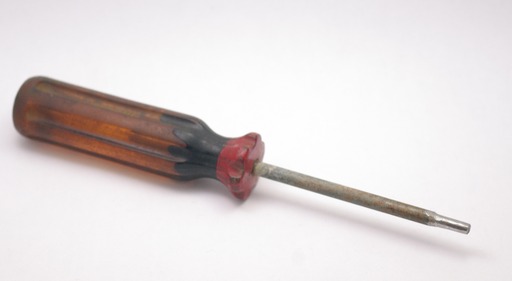
Below left this pin wrench is shown in use tightening (or loosening) a checknut in the set width adjustment mechanism of a Thompson Type-Caster. This is an operation that one performs repeatedly during type casting. Below right it is shown during maintenance on the same machine, loosening a machine screw. It is also used on the Thompson for adjusting the vertical alignment of the matrix in the Matrix Holder and for operating the eccentrics which raise and lower the top blocks of the Mold. You can't do much on a Thompson without a pin wrench. It is also used on the Ludlow Typograph Machine (not shown here) during maintenance to adjust the main vertical slide of the machine.
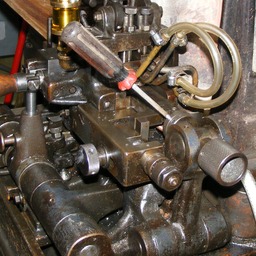
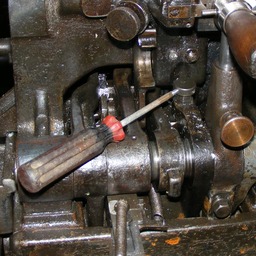
The pin wrench shown above is not a commercially made item; I made it myself by grinding the end off of an old and no longer useable screwdriver.
Here is an example of a pin wrench that was once commercially manufactured and called by its makers a "pin wrench." It is from a catalog of the Hartzell Machine Works of Chester, PA (undated, but probably late 1960s). Hartzell specialized in the repair of and the making of new parts for Monotype type casting machines. The Hartzell pin wrench is two-ended where my shop-made version has a handle, but they are functionally equivalent.
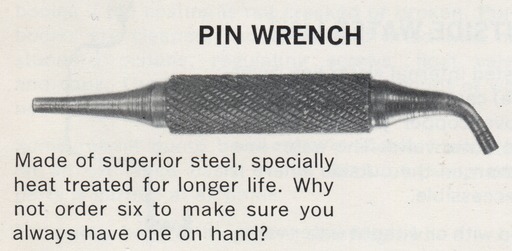
All of this might seem very straightforward, but it is not. If you go out to the vast Internet today in search of a "pin wrench," you will find many things called "pin wrenches," but not a single one of them is either version of the tool shown here. Instead, you will find variations on two other tools.
The first of the two kinds of wrenches you will find if you search the Internet for "pin wrench" is something that looks like this:
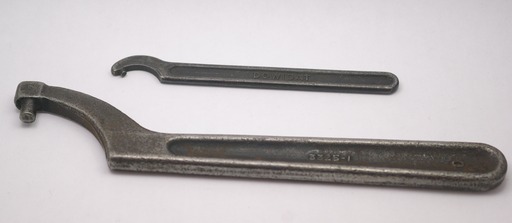
I believe that the tools shown above are most correctly called "Pin Spanner Wrenches" in America.
There is a close variation on this wrench which terminates not in a pin designed to go into a hole but in a hook designed to catch on a lip - the "Hook Spanner Wrench":
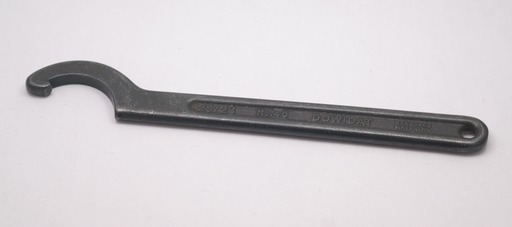
The use of the term "pin wrench" to indicate this kind of wrench may be a modern simplification of earlier, more descriptive, terminology. Here are some documented historical uses.
In Colvin, Fred H. and Frank A. Stanley. Machine Shop Primer (NY: McGraw-Hill Book Company, 1910) both the hook and pin versions of this wrench are shown, along with the two-pin version to be discussed in the next section. All three of these wrenches shown are called "Spanner Wrenches" (and no other kinds of wrench shown is called a "Spanner Wrench.") The two under consideration in this section are called, specifically "Spanner Wrench, Hook" (No. 490 in the image below) and "Spanner Wrench, Pin" (No. 491 below).
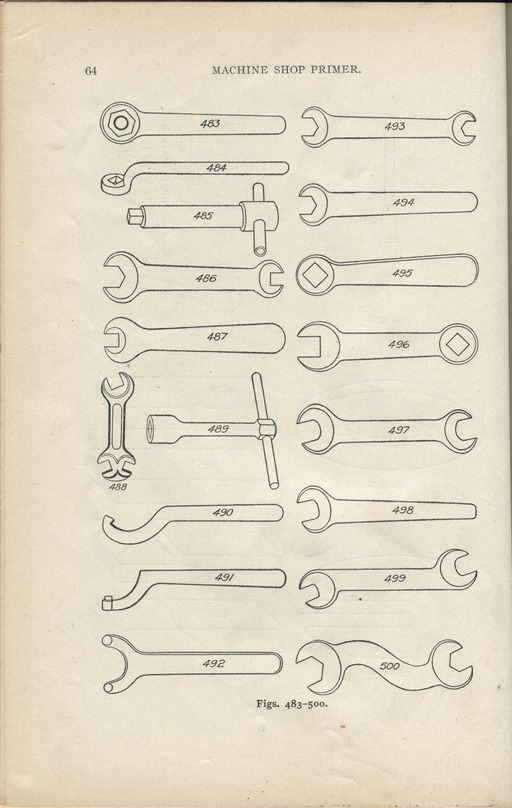
(This entire book has been digitized by Google from the University of Michigan copy. However, while that digitization is convenient, I was not satisfied with its low-resolution scan of this page. I've therefore scanned it from my own copy; this is the scan presented here. It's 18 Megabytes if you click through, which is admittedly a bit much for simple line art - but this way you can zoom in and see the texture of the paper.)
Colvin and Stanley wrote with some authority. Colvin was editor of American Machinist and the American Machinist's Handbook that they edited together was, in its day, in many ways better than Machinery's Handbook.
So it would seem that in 1910 in the US some of the best authorities on the subject called this style of wrench, when furnished with a pin, a "Pin Spanner Wrench" (where "spanner" is a subclass of "wrench"), not a "Pin Wrench."
For an example of mid-century usage, it is illuminating to turn to the catalog of the Charles A. Strelinger company (a major supplier at the time). They call wrenches of this kind "Pin Spanners" (meaning Pin Spanner Wrenches; as can be seen from the index, they are using American terminology whereby a spanner is a particular kind of wrench).
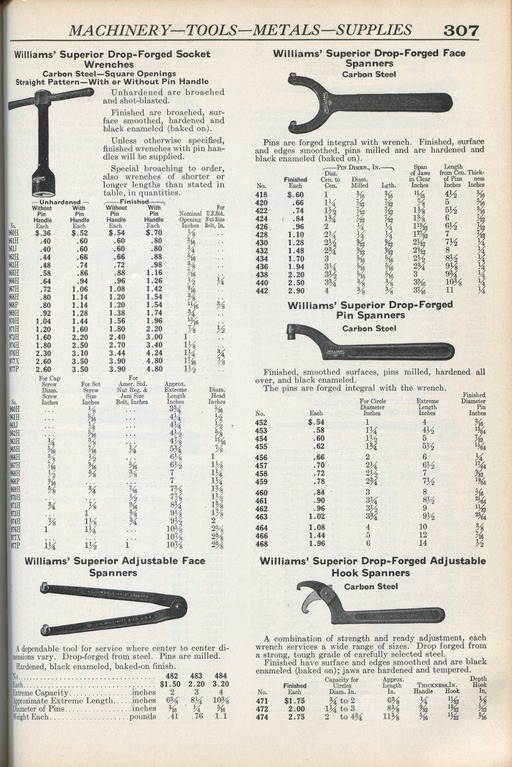
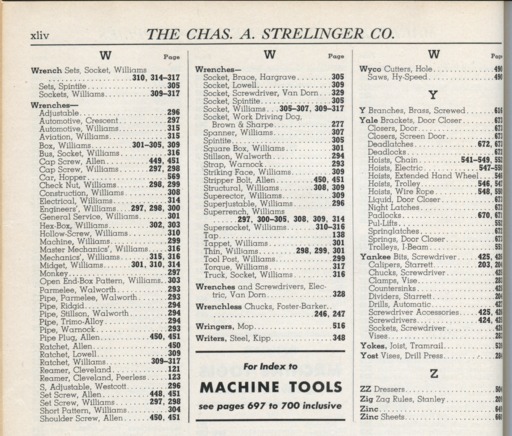
Here's another kind of wrench with pins in it:
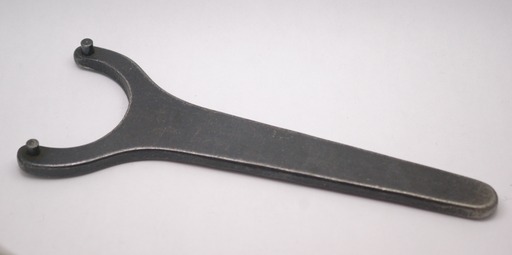
Here is a different style of this kind of wrench (in this case with a double-bend in the handle):
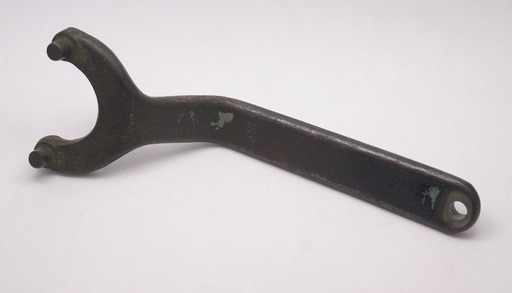
(Photograph by the author. This wrench is used with a Gorton Model 375-4 Cutter Grinder to tighten or loosen the nut used to retain the grinding wheel on the spindle.)
Wikipedia's article on wrenches (which is quite good) notes that in both American and English usage tools such as these would be called either "Pin Face Spanners" or "C Spanners" in both American and British usage. This isn't wrong, but isn't quite precise, either.
In British usage, "Pin Face Spanner" would indicates a sub type ("pin") of a type ("face") within the general category of "spanners".
In American usage, "Pin Face Spanner" isn't the full name; "Pin Face Spanner Wrench" is. This indicates a sub-sub-type ("pin") of a subtype ("face") of a type ("spanner") within the general category of "wrenches."
Nevertheless, if you look up "pin wrench" online, you'll find a lot of these.
Here are two other versions of this kind of wrench:
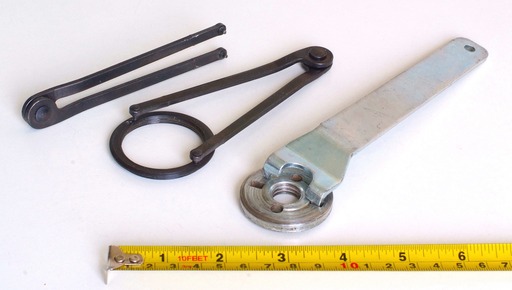
The style on the left (above) is one used typically to remove components and accessories from photographic lenses. The style on the right is used to remove the nut holding the grinding wheel on an angle grinder.
(Source: A photograph by Wikimedia user Nutzdatenbegleiter from http://commons.wikimedia.org/wiki/File:Stirnlochschluessel.jpg)
As is the case with the "Pin Spanner Wrench" shown earlier, the use of the term "pin wrench" to refer to this two-pin type of wrench would seem to be a modern instance of imprecision in language. Colvin and Stanley's Machine Shop Primer put it in the subclass of wrenches called "Spanner Wrenches" and distinguish it specifically as a "Spanner Wrench, Pin Face" (no. 492 in their illustration). The Strelinger company did the same when selling such wrenches in 1942 (though as there is no "hook" version they omitted the "pin" part of the name).
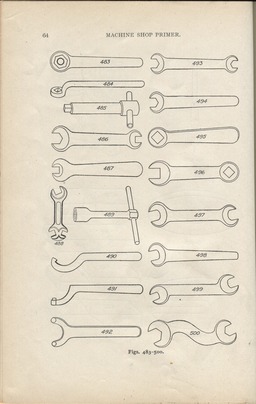
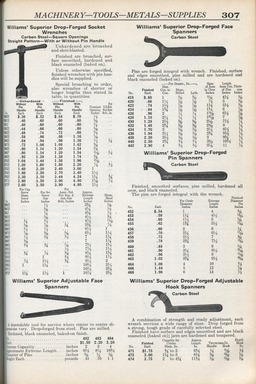
It would appear that the versatile Pin Wrench can be all things to all people at the same time - and more.
The illustration below is cropped from a page of the Spare Parts List for English Monotype Composition and Type-&-Rule type casting machines (Salfords, UK: The Monotype Corporation Limited, 1969). It shows three entirely different kinds of tools each of which is identified (in the accompanying text, not shown as an image here) as a "pin wrench."
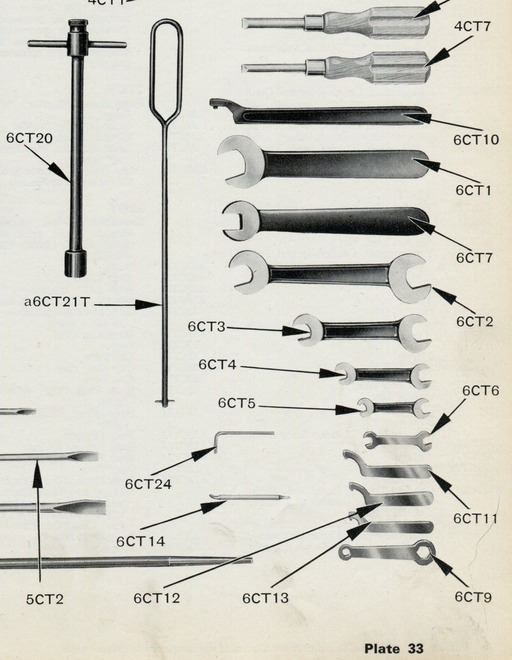
The first four of these are Pin Spanner Wrenches. The fifth (6CT14) is a Pin Wrench as I originally understood the term. The sixth (a6CT21T) is a special-purpose tool for these machines which is unrelated to any other "pin wrench."
This usage was well established by this time. In the 1946 equivalent of this book, Book of Parts of 'Monotype' Casting Machines (Salfords, UK: The Monotype Corporation Limited, 1946) the first four of these appear with the same part numbers and only slightly different descriptions:
Colvin and Stanley's 1910 Machine Shop Primer is in the public domain. My scans from it remain in the public domain.
The copyright on the 1942 Strelinger catalog no. 58 was not renewed, as was then required. It is therefore in the public domain. The extracts from that digitization reprinted here remain in the public domain.
The image Stirnlochschluessel.jpg is licensed by its author, wikimedia user Nutzdatenbegleiter, under the Creative Commons Attribution ShareAlike 3.0 Unported license.
The 1969 Monotype Corporation Spare Parts List is in copyright in both the UK and US. However, I believe that my use of partial extract here for scholarly purposes is within the limits of "fair use" under US copyright law. Please note that it is therefore not subject to the same Creative Commons license as this page overall.
All portions of this document not noted otherwise are Copyright © 2012 by David M. MacMillan and Rollande Krandall.
Circuitous Root is a Registered Trademark of David M. MacMillan and Rollande Krandall.
This work is licensed under the Creative Commons "Attribution - ShareAlike" license. See http://creativecommons.org/licenses/by-sa/3.0/ for its terms.
Presented originally by Circuitous Root®
Select Resolution: 0 [other resolutions temporarily disabled due to lack of disk space]